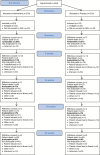The association of health-related quality of life and cognitive function in patients receiving memantine for the prevention of cognitive dysfunction during whole-brain radiotherapy
- PMID: 31386073
- PMCID: PMC6660822
- DOI: 10.1093/nop/npy038
The association of health-related quality of life and cognitive function in patients receiving memantine for the prevention of cognitive dysfunction during whole-brain radiotherapy
Abstract
Background: This study evaluated the association between health-related quality of life (HRQOL) and cognition in patients receiving memantine for prevention of cognitive dysfunction during whole-brain radiotherapy (WBRT).
Methods: Adult patients with brain metastases received WBRT and were randomized to receive placebo or memantine, 20 mg per day, within 3 days of initiating radiotherapy, for 24 weeks. The Functional Assessment of Cancer Therapy-Brain module (FACT-Br) and Medical Outcomes Scale-Cognitive Functioning Scale (MOS-C) were completed in coordination with serial standardized tests of cognitive function.
Results: Of the 508 eligible patients, 442 (87%) consented to participate in the HRQOL portion and contributed to baseline analyses. Evaluable patients at 24 weeks (n = 246) included surviving patients completing FACT-Br, MOS-C, and objective cognitive assessments (n = 146, 59%) and patients alive at time of missed assessment (n = 100, 41%). Baseline cognitive function correlated significantly with FACT-Br and MOS-C self-reports. All domains of objective cognitive function showed declines over time. Neither FACT-Br nor MOS-C differed between the treatment arms. Emotional and functional well-being subscales of the FACT improved over time while the remainder of the FACT-Br domains remained stable. MOS-C scores declined over time.
Conclusion: Baseline cognitive function correlated significantly with FACT-Br and MOS-C scores. No by-arm differences in HRQOL were observed despite differences in objective cognitive function. Patient attrition and poor testing compliance remain significant problems in studies of cognitive function of brain metastases patients and further effort is needed to improve compliance with testing and sensitivity of patient-reported measures.
Keywords: brain metastases; quality of life; radiotherapy.
Figures
Similar articles
-
Memantine for the prevention of cognitive dysfunction in patients receiving whole-brain radiotherapy: a randomized, double-blind, placebo-controlled trial.Neuro Oncol. 2013 Oct;15(10):1429-37. doi: 10.1093/neuonc/not114. Epub 2013 Aug 16. Neuro Oncol. 2013. PMID: 23956241 Free PMC article. Clinical Trial.
-
Do patients with brain metastases selected for whole brain radiotherapy have worse baseline quality of life as compared to those for radiosurgery or neurosurgery (with or without whole brain radiotherapy)?Ann Palliat Med. 2016 Jan;5(1):1-12. doi: 10.3978/j.issn.2224-5820.2015.11.01. Ann Palliat Med. 2016. PMID: 26841810
-
Epilepsy in patients with primary brain tumors: The impact on mood, cognition, and HRQOL.Epilepsy Behav. 2015 Jul;48:88-95. doi: 10.1016/j.yebeh.2015.03.016. Epub 2015 Jun 29. Epilepsy Behav. 2015. PMID: 26136184
-
FACT-Br for assessment of quality of life in patients receiving treatment for brain metastases: a literature review.Expert Rev Pharmacoecon Outcomes Res. 2011 Dec;11(6):701-8. doi: 10.1586/erp.11.67. Expert Rev Pharmacoecon Outcomes Res. 2011. PMID: 22098286 Review.
-
Preservation of cognitive function following whole brain radiotherapy in patients with brain metastases: Complications, treatments, and the emerging role of memantine.J Oncol Pharm Pract. 2019 Apr;25(3):657-662. doi: 10.1177/1078155218798176. Epub 2018 Sep 10. J Oncol Pharm Pract. 2019. PMID: 30200844 Review.
Cited by
-
PRO: Do We Still Need Whole-Brain Irradiation for Brain Metastases?Cancers (Basel). 2023 Jun 15;15(12):3193. doi: 10.3390/cancers15123193. Cancers (Basel). 2023. PMID: 37370802 Free PMC article. Review.
-
Missing repeated measures data in clinical trials.Neurooncol Pract. 2021 Jul 16;9(1):35-42. doi: 10.1093/nop/npab043. eCollection 2022 Feb. Neurooncol Pract. 2021. PMID: 35096402 Free PMC article. Review.
-
Memantine in the Prevention of Radiation-Induced Brain Damage: A Narrative Review.Cancers (Basel). 2022 May 31;14(11):2736. doi: 10.3390/cancers14112736. Cancers (Basel). 2022. PMID: 35681716 Free PMC article. Review.
-
The Alliance AMBUSH Trial: Rationale and Design.Cancers (Basel). 2022 Jan 14;14(2):414. doi: 10.3390/cancers14020414. Cancers (Basel). 2022. PMID: 35053576 Free PMC article. Review.
-
Therapeutic role of memantine for the prevention of cognitive decline in cancer patients with brain metastasis receiving whole-brain radiotherapy: a narrative review.Dement Neuropsychol. 2022 Jul-Sep;16(3):270-275. doi: 10.1590/1980-5764-DN-2021-0102. Epub 2022 May 23. Dement Neuropsychol. 2022. PMID: 36619840 Free PMC article.
References
-
- Patchell RA, Tibbs PA, Regine WF, et al. . Postoperative radiotherapy in the treatment of single metastases to the brain: a randomized trial. JAMA. 1998;280(17):1485–1489. - PubMed
-
- Klein M, Taphoorn MJ, Heimans JJ, et al. . Neurobehavioral status and health-related quality of life in newly diagnosed high-grade glioma patients. J Clin Oncol. 2001;19(20):4037–4047. - PubMed
-
- Armstrong CL, Gyato K, Awadalla AW, Lustig R, Tochner ZA. A critical review of the clinical effects of therapeutic irradiation damage to the brain: the roots of controversy. Neuropsychol Rev. 2004;14(1):65–86. - PubMed
-
- Zelen M. The randomization and stratification of patients to clinical trials. J Chronic Dis. 1974;27(7-8):365–375. - PubMed



